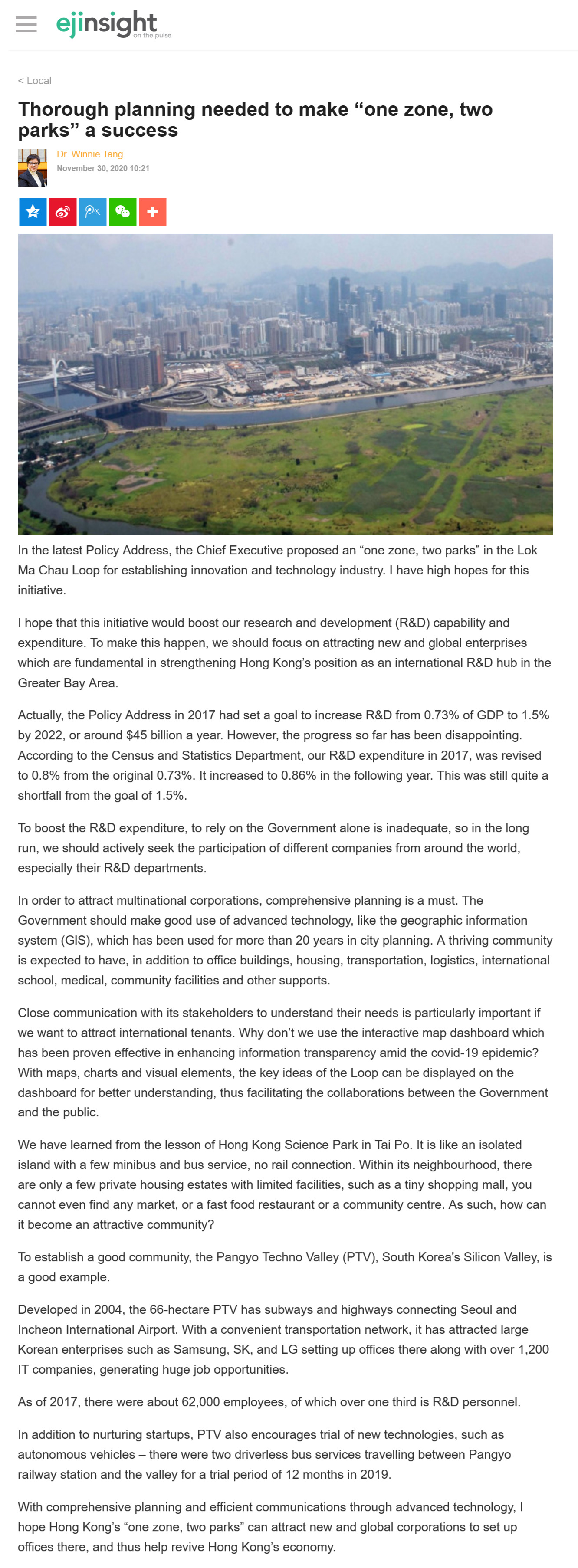網上版請按此

Thorough planning needed to make "one zone, two parks" a success
In the latest Policy Address, the Chief Executive proposed an "one zone, two parks" in the Lok Ma Chau Loop for establishing innovation and technology industry. I have high hopes for this initiative.
I hope that this initiative would boost our research and development (R&D) capability and expenditure. To make this happen, we should focus on attracting new and global enterprises which are fundamental in strengthening Hong Kong's position as an international R&D hub in the Greater Bay Area.
Actually, the Policy Address in 2017 had set a goal to increase R&D from 0.73% of GDP to 1.5% by 2022, or around $45 billion a year. However, the progress so far has been disappointing. According to the Census and Statistics Department, our R&D expenditure in 2017, was revised to 0.8% from the original 0.73%. It increased to 0.86% in the following year. This was still quite a shortfall from the goal of 1.5%.
To boost the R&D expenditure, to rely on the Government alone is inadequate, so in the long run, we should actively seek the participation of different companies from around the world, especially their R&D departments.
In order to attract multinational corporations, comprehensive planning is a must. The Government should make good use of advanced technology, like the geographic information system (GlS), which has been used for more than 20 years in city planning. A thriving community is expected to have, in addition to office buildings, housing, transportation, logistics, international school, medical, community facilities and other supports.
Close communication with its stakeholders to understand their needs is particularly important if we want to attract international tenants. Why don't we use the interactive map dashboard which has been proven effective in enhancing information transparency amid the covid-19 epidemic? With maps, charts and visual elements, the key ideas of the Loop can be displayed on the dashboard for better understanding, thus facilitating the collaborations between the Government and the public.
We have learned from the lesson of Hong Kong Science Park in Tai Po. It is like an isolated island with a few minibus and bus service, no rail connection. Within its neighbourhood, there are only a few private housing estates with limited facilities, such as a tiny shopping mall, you cannot even find any market, or a fast food restaurant or a community centre. As such, how can it become an attractive community?
To establish a good community, the Pangyo Techno Valley (PTV), South Korea's Silicon Valley, is a good example.
Developed in 2004, the 66-hectare PTV has subways and highways connecting Seoul and Incheon International Airport. With a convenient transportation network, it has attracted large Korean enterprises such as Samsung, SK, and LG setting up offices there along with over 1,200 IT companies, generating huge job opportunities.
As of 2017, there were about 62,000 employees, of which over one third is R&D personnel.
In addition to nurturing startups, PTV also encourages trial of new technologies, such as autonomous vehicles – there were two driverless bus services travelling between Pangyo railway station and the valley for a trial period of 12 months in 2019.
With comprehensive planning and efficient communications through advanced technology, I hope Hong Kong's "one zone, two parks" can attract new and global corporations to set up offices there, and thus help revive Hong Kong's economy.
Dr. Winnie Tang
Adjunct Professor, Department of Geography, Faculty of Social Sciences and Faculty of Architecture, The University of Hong Kong